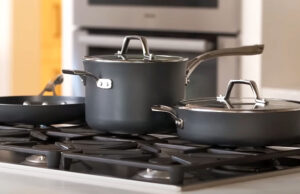As an Amazon Associate, I earn from qualifying purchases at no extra cost to you.
How Far Can Dishwasher Be From Sink? Expert Guide
You probably wonder how far your dishwasher can be from the sink when setting up your kitchen. It’s a common question because having your dishwasher too far can make installation harder and affect how well it works. The good news is, your dishwasher should be close enough to the sink so water lines and drainage can connect easily, usually within a few feet. In this article, you will learn everything about the best distance for your dishwasher from the sink, why it matters, and how to plan it right for your kitchen.
Understanding Why Distance Matters Between Dishwasher and Sink
When you think about putting your dishwasher near the sink, you might only consider convenience. But the distance between these two is more important than you think. Your dishwasher needs water supply and a way to drain dirty water, which usually comes from the sink’s plumbing. If the dishwasher is too far, the hoses that connect it to water and drainage may not reach or might cost more to extend.
A dishwasher works by pulling water through a hose connected near the sink. If this hose is too long, it can lower water pressure, making the dishwasher less effective at cleaning. Also, longer drain hoses can cause water to sit inside the dishwasher, leading to bad smells or leaks. So, keeping the dishwasher close to the sink means better water flow and fewer problems over time.
In addition to plumbing, electrical setup matters too. The closer your dishwasher is to the sink, the easier it is to manage all cables and pipes neatly under the counter. This also keeps your kitchen safe and looking good.
If your kitchen layout makes it hard to put the dishwasher right next to the sink, don’t worry. There are ways to plan and install it safely even if it is a little further. But, generally, most dishwashers should be no more than 10 feet away from the sink for smooth operation. Longer distances might need professional help and extra equipment.
- Dishwasher must connect to water and drainage near the sink
- Too far distance can reduce water pressure and cause poor cleaning
- Long drain hoses can cause water to stay inside dishwasher
- Closer placement makes plumbing and electrical work easier
- 10 feet is a general maximum distance for dishwasher from sink
- Longer distances need extra work and care
How to Measure the Distance Between Dishwasher and Sink Correctly
To make sure your dishwasher will work well and fit in your kitchen, measuring the distance from your sink is very important. This step helps you plan where to place the dishwasher and what kind of plumbing you will need.
Start by measuring the space under your kitchen counter where your dishwasher will go. Measure from the edge of the sink cabinet to where you want the dishwasher to sit. It is best to measure in a straight line if the dishwasher will be directly next to the sink. But if there are cabinets or other obstacles, you may need to measure the path the hoses will take.
The water supply line and drain hose usually run behind or under cabinets. If you plan to place the dishwasher a bit away from the sink, check if there is a clear route for these hoses. You might need to measure from the water valve near the sink to where the dishwasher will be.
If you don’t know where the water valves are, look under the sink. Usually, you will see pipes and a valve that can be turned off. This valve is important because the dishwasher hose will connect here.
Also, measure the length of your dishwasher hoses if you already have the appliance. Most dishwashers come with 5 to 6 feet of hose. If the distance you measured is longer than the hose length, you will need to buy extra hoses or connectors.
Keep in mind that it’s better to have a little extra length than too little. But avoid making hoses too long because it can cause problems with water flow.
- Measure space under counter from sink to dishwasher spot
- Check route for water and drain hoses behind cabinets
- Find water valve under the sink for connection
- Dishwasher hoses usually 5-6 feet long, measure hose length
- Extra hose needed if distance is longer than hose length
- Avoid too long hoses to keep water pressure good
What Is the Ideal Distance for Dishwasher Placement From Sink?
Knowing the ideal distance for your dishwasher from the sink helps make installation easier and your kitchen work better. The best distance depends on your kitchen size and layout, but there are general rules most people follow.
Usually, dishwashers are placed right next to the sink cabinet. This means the dishwasher door opens near the sink, making it easy to scrape plates and load them without moving far. Also, plumbing and electrical connections are close, so installation is simpler.
If your kitchen layout does not allow for the dishwasher to be right beside the sink, try to keep it within 3 to 6 feet. This distance is close enough for hoses to work properly without extra tools.
Some kitchens may have the dishwasher placed a bit farther, up to 10 feet. But when the dishwasher is this far, the installer must take care to use special long hoses or pumps to keep water flowing well.
Remember, if the dishwasher is too far away, water pressure can drop, and dirty water may not drain well. This can cause smells and even damage your dishwasher over time.
For the best kitchen flow and dishwasher performance:
- Place dishwasher next to sink cabinet if possible
- Keep dishwasher within 3 to 6 feet for easy plumbing
- Maximum recommended distance is about 10 feet
- Longer distances need extra plumbing parts or help
- Close distance makes washing and unloading dishes easier
- Distance affects water pressure and drainage quality
How Plumbing and Drainage Work With Dishwasher Distance
Understanding how plumbing and drainage work can help you see why distance matters. Your dishwasher needs a water supply line to fill with water and a drain hose to get rid of dirty water after washing.
The water supply line usually connects to the cold water valve under your kitchen sink. This valve controls the water flow to your dishwasher. The drain hose connects to the sink’s drain pipe or garbage disposal.
If the dishwasher is very close to the sink, these hoses can be short and simple. But if the dishwasher is far away, the hoses must be longer, and this can cause problems.
Long water supply lines can lose pressure, which means the dishwasher may not get enough water during washing. Long drain hoses can let water flow back into the dishwasher or cause it to drain slowly. This happens because water has to flow uphill or around bends in the hose.
To fix this, plumbers sometimes add a drain pump or use a special hose called an air gap to keep water flowing in the right direction. These parts help prevent water from going back into the dishwasher.
Also, the hoses must be properly secured and not bent tightly. Kinks in hoses can stop water flow and cause leaks.
Good plumbing means your dishwasher fills, cleans, and drains water fast. Poor plumbing from too much distance means poor cleaning and more repairs.
- Dishwasher connects to cold water valve under sink
- Drain hose connects to sink drain or garbage disposal
- Short hoses work better for water pressure and drainage
- Long hoses can cause low water pressure and slow drainage
- Drain pumps or air gaps help when dishwasher is far
- Hoses must be straight and not bent to avoid leaks
Tips for Installing a Dishwasher Far From the Sink
Sometimes your kitchen design forces you to put the dishwasher far from the sink. Maybe you have a big kitchen island or a strange cabinet layout. Don’t worry, there are ways to install it safely and make it work well even if it’s far.
First, use longer water supply and drain hoses made for dishwashers. Make sure the hoses are strong and the right size. Avoid cheap or thin hoses because they can break or leak.
Second, consider adding a drain pump or a booster pump. These small devices help push water out of the dishwasher and improve water flow from the faucet. A drain pump is very helpful if the dishwasher’s drain hose must go uphill or has a long run.
Third, install an air gap if required by local building codes. An air gap is a small device that stops dirty water from flowing back into the dishwasher. It is often placed on the sink or countertop near the dishwasher.
Fourth, check that the water supply valve is easy to reach and works well. If it is too far, you may need a special valve or extra plumbing work.
Finally, hire a professional plumber if you feel unsure about the distance or installation. They have the tools and experience to do the job right and keep your dishwasher working well for years.
- Use long, strong dishwasher hoses
- Add drain or booster pumps if needed
- Install an air gap to prevent backflow
- Ensure water valve is accessible and working
- Consider professional help for long distances
- Proper installation avoids leaks and poor cleaning
How Kitchen Layout Affects Dishwasher Distance From Sink
Your kitchen layout plays a big role in how far your dishwasher can be from the sink. In many homes, the kitchen is designed so the dishwasher sits right next to the sink for easy use. But some kitchens have islands, open spaces, or unusual cabinet shapes that change where the dishwasher can go.
If you have a kitchen island, the dishwasher may be placed on the island, which could be several feet from the sink. In this case, you must plan how water and drain hoses will run under the floor or through cabinets. This can make installation more expensive and complicated.
In kitchens with open plans or L-shaped counters, the dishwasher may be across the room from the sink. This setup is possible but requires longer hoses and possibly pumps to keep everything working well.
When planning your kitchen layout, think about how you will use the sink and dishwasher together. You will want to move dishes easily between them. The closer they are, the easier washing and loading dishes becomes.
Also, think about the space needed to open the dishwasher door and move around without bumping into things.
Good kitchen design balances style and function. Placing your dishwasher too far from the sink can cause plumbing and cleaning issues, but sometimes it’s necessary because of your layout.
- Kitchen islands may place dishwasher far from sink
- Open or L-shaped kitchens can have distant dishwasher
- Longer hoses and pumps may be needed for such layouts
- Think about easy dish transfer between sink and dishwasher
- Allow space for dishwasher door and kitchen movement
- Kitchen style affects dishwasher distance and plumbing needs
Final Thoughts
Choosing how far your dishwasher can be from the sink is very important for your kitchen’s function. Keeping the dishwasher close to the sink, usually within 3 to 6 feet, makes plumbing easy and helps the dishwasher work well. If it must be farther, up to 10 feet, extra steps like longer hoses and pumps are needed. Your kitchen layout, plumbing, and cleaning habits all affect the best distance. Planning carefully will save you time, money, and frustration, and make your kitchen a happy, clean place to cook and eat.
Frequently Asked Questions (FAQs)
Is it okay to have dishwasher more than 10 feet from sink?
Having a dishwasher more than 10 feet from the sink is possible but not ideal. When the distance is over 10 feet, you will need special long hoses, pumps, and possibly extra plumbing parts. Long water supply lines may reduce water pressure, and long drain hoses can cause slow drainage or leaks. Installation becomes more complicated and expensive. If you want to put your dishwasher very far from the sink, it’s best to get a professional plumber to plan and install everything to avoid problems.
Can I use any hose length for dishwasher installation?
No, you cannot use any hose length. Most dishwashers come with hoses around 5 to 6 feet long, which are designed for normal kitchen layouts. Using hoses that are too long or too short can cause leaks, poor water flow, and dishwasher damage. If your kitchen requires longer hoses, make sure to buy hoses made specifically for dishwashers. They should be strong, durable, and the right size. Also, avoid sharp bends or kinks in the hose to keep water flowing well.
Do I need a professional to install dishwasher if it’s far from sink?
It is highly recommended to hire a professional plumber if your dishwasher will be far from the sink. Long distances need careful plumbing and sometimes special equipment like pumps or air gaps. Professionals know the local codes and how to install everything safely and correctly. Trying to install it yourself without experience can cause leaks, poor dishwasher performance, or even damage to your kitchen. A good plumber will save you time and money in the long run.
Is it important to install an air gap with dishwasher far from sink?
Yes, installing an air gap is very important if your dishwasher is far from the sink, or if local building codes require it. An air gap is a small device that stops dirty water from flowing back into the dishwasher. This helps keep your dishes clean and protects your plumbing system. Without an air gap, water could flow back and cause contamination or damage. It is often installed on the sink or countertop near the dishwasher.
Can dishwasher drain hose go uphill?
Dishwasher drain hoses should not go uphill without help because water will have trouble flowing. If your drain hose must go uphill, a drain pump or an air gap is usually needed. These help push the water out of the dishwasher and prevent it from getting stuck or flowing backward. Improper hose placement can cause water to sit in the dishwasher, leading to smells and poor cleaning. Always follow manufacturer instructions and local codes for drain hose installation.
Do I lose dishwasher warranty if installed far from sink?
Dishwasher warranty usually does not depend on distance from the sink alone. However, if the installation does not follow the manufacturer’s guidelines, such as using correct hose lengths or proper plumbing, it could void the warranty. Always check the installation instructions that come with your dishwasher. If you install it yourself far from the sink, make sure everything is done right. Using a professional installer can help keep your warranty valid.
Is it better to have dishwasher next to sink or island?
Having your dishwasher next to the sink is usually better because it makes plumbing easier and loading dishes faster. You can quickly scrape and rinse dishes, then load them without moving much. However, if your kitchen has an island, placing the dishwasher there is possible but requires longer hoses and special plumbing. Both options can work well, but next to the sink is simpler and usually less expensive to install and maintain.
Can I extend dishwasher hoses safely?
Yes, you can extend dishwasher hoses safely if you use the right parts. Use hoses made for dishwashers and connectors that fit tightly without leaks. Avoid using regular garden hoses or cheap materials because they are not built for dishwasher water pressure and temperature. Make sure the extended hoses do not have sharp bends or kinks. If you need very long hoses, consult a professional to ensure your dishwasher will work correctly without leaks or pressure problems.




